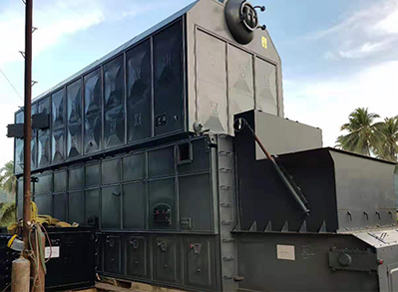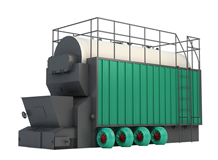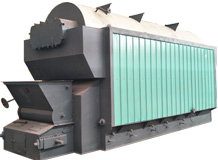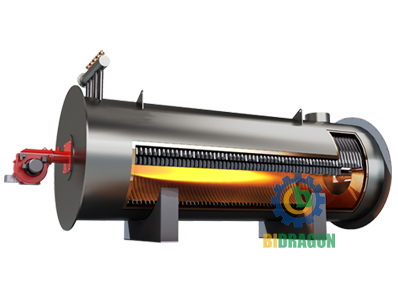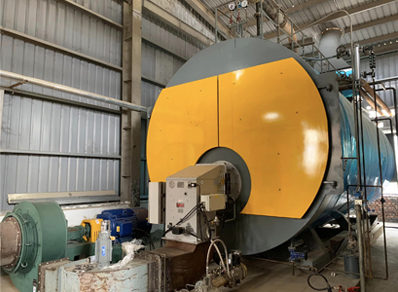
Industrial Steam Boiler Maintenance:Step by Step Guide
Industrial steam boilers are used in a wide range of industries to generate steam by heating water for heating, power generation, and a variety of industrial processes. From the textile industry, where steam is used to shape fabrics, to the food processing industry, where steam is used to cook ingredients, to the chemical industry, where steam is used to drive chemical reactions, industrial steam boilers play an irreplaceable role in keeping production processes running smoothly. In order to ensure the stability and efficiency of the production process, it is vital that industrial steam boilers are properly maintained.
Why Maintenance is Critical for Boilers
Preventing Boiler Failure
The primary importance of maintenance is to prevent boiler failure. A boiler failure can result in hours or even days of downtime, which can be costly in many industries. For example, in the paper industry, a boiler failure can force the paper production line to be interrupted, not only halting production, but also causing huge financial losses due to the scrapping of unfinished paper products and the cleanup of equipment before it is restarted.
According to statistics, some large manufacturing enterprises due to boiler failure caused by production stoppages, daily losses of up to hundreds of thousands of dollars or more. Through regular maintenance, potential problems can be detected in time, such as checking the wear and tear of boiler piping, ensuring the normal operation of the control system, etc., thus effectively avoiding failures and guaranteeing the continuity of production.
Improve Safety and Reliability
Poorly maintained boilers are prone to problems such as uncontrolled pressure and steam leakage. Excessive pressure can cause boiler explosions, while steam leaks can scald operators, posing a serious threat to the lives of employees. The consequences of these safety incidents are unimaginable.
Meanwhile, well-maintained boilers offer greater reliability. For example, in the pharmaceutical industry, a stable supply of steam is critical to the production process of pharmaceuticals. Reliable boiler operation ensures the stability of drug quality and avoids drug quality problems due to unstable steam supply.
Reduced Replacement Costs
Frequent repairs, replacement parts, and losses due to production stoppages can cause a significant increase in operating costs. At the same time, inefficient boilers consume more energy, further burdening your organization's finances. Therefore, following best maintenance practices is essential to ensure optimal boiler performance and longevity.
Regular cleaning and maintenance of boilers can slow down the rate of corrosion of internal components and extend their service life. For example, if an industrial steam boiler worth hundreds of thousands of dollars has its major component replacement cycle extended from five to eight years through good maintenance, a significant amount of replacement costs can be saved, while also reducing downtime and production losses due to component replacement.
Improved Energy Efficiency
Energy losses can be minimized through measures such as maintaining quality insulation, which means less fuel is needed to run the boiler. Good insulation stops heat from escaping into the surrounding environment, allowing more heat to be used to heat water to produce steam. Studies have shown that a well-maintained, insulated boiler can save 10%-20% of annual fuel costs compared to a boiler that is not effectively maintained. This not only reduces operating costs, but also meets the environmental requirements of energy conservation and emission reduction.
Realize More Water Savings
Regular inspections protect boiler water and steam resources by addressing potential leaks before they appear or worsen. For example, timely detection and repair of small leaks in steam piping can prevent the waste of large amounts of water. At the same time, developing a more efficient discharge process can minimize water loss during discharge while maintaining boiler water quality. It is estimated that after optimizing the sewage process, boilers in some industrial enterprises can save thousands of cubic meters of water per year.
Reduce Downtime During Annual Inspections
Regular maintenance of steam boilers reduces the downtime required during annual inspections, when the boiler is already in a good state of maintenance. Ensuring that the boiler's components are functioning properly through routine and periodic maintenance, such as cleaning the boiler's interior of accumulated scale and checking the accuracy of safety devices in advance of the annual inspection, can make the inspection process smoother and shorten the inspection time. In addition, predictable downtime for regular maintenance allows companies to rationalize production schedules and avoid loss of productivity due to boiler maintenance.
Second, what needs to be checked.
Steam Boiler Maintenance Points& Treatment Methods
Leakage
Boiler leaks can be caused by damaged seals, ruptured pipes or corrosion. When leaks are found, for smaller sealing leaks, sealant can be used to seal; if the pipe is ruptured, the damaged pipe components need to be replaced in a timely manner; for leaks due to corrosion, in addition to repairing the leakage point, it is also necessary to take appropriate water treatment measures, such as the addition of corrosion inhibitors, in order to prevent further corrosion. For example, a factory's steam boiler due to long-term piping erosion by high-temperature steam and impurities in the water, corrosion leakage. By replacing the corroded piping in a timely manner and adjusting the water treatment program, the leak was effectively resolved and greater losses were avoided.
Pressure Problems
Fluctuations in boiler pressure can lead to reduced efficiency and safety hazards. Excessive pressure can trigger an explosion risk, while low pressure can affect steam generation and delivery. Pressure problems can be addressed by adjusting the pressure control system, such as checking that the pressure regulator is working properly and calibrating the pressure setting. Also, regular maintenance of pressure sensors and related valves ensures the accuracy of pressure control. For example, during the heating season, the steam boilers of some heating companies have unstable heating results due to pressure fluctuations. After a comprehensive inspection and maintenance of the pressure control system, the parameters of the pressure regulator were adjusted to keep the boiler pressure stable and ensure the normal heating.
Control Device Failure
Failure of the control device can cause the boiler to operate abnormally. For example, temperature control device failure may make the boiler temperature too high or too low, affecting the production process. Control device failures can be resolved by recalibrating control parameters, repairing or replacing faulty components. At the same time, it is important to ensure that communication between the controls is normal, for example, by checking whether the connecting wiring between the controller and the sensors and actuators is loose or damaged. A food processing plant's steam boiler had a faulty temperature control device, resulting in unstable food cooking temperatures and affecting product quality. By recalibrating the temperature controller and replacing the damaged temperature sensor, the technician restored stable control of the boiler temperature and ensured the quality of food processing.
Ignition Problems
Boiler ignition problems can interfere with the combustion process. Common ignition problems include scale buildup on the ignition electrode and poor gas supply. For ignition electrode scaling, cleaning can be carried out regularly; if the gas supply is not smooth, it is necessary to check whether the gas pipeline is blocked and whether the gas valve is opened normally. For example, a hotel's steam boiler in the winter frequent ignition difficulties, after checking the ignition electrode was found to have accumulated a lot of dirt, affecting the ignition effect. After cleaning the ignition electrode, the boiler ignition returned to normal, ensuring the hotel's hot water and heating supply.
Burner Problems
Burner problems, such as uneven flame or incomplete combustion, affect efficiency and emissions. Regular cleaning of the burner to remove carbon and impurities inside the burner and adjusting the air-to-gas ratio of the burner can improve combustion. At the same time, burner nozzles should be checked regularly for clogging and wear, and cleaned or replaced in a timely manner. For example, a power plant's steam boiler burner due to long-term operation, nozzle wear and tear is serious, resulting in uneven flame, combustion efficiency is reduced. After replacing the nozzles and readjusting the burner parameters, the combustion efficiency was significantly improved, reducing fuel consumption and pollutant emissions.
Corrosion and Scaling Problems
Corrosion and scaling of internal boiler components can reduce heat transfer efficiency. For scaling problems, chemical cleaning or mechanical cleaning can be used to remove scale. Chemical cleaning is done by adding a suitable descaling agent to the boiler to dissolve the scale; mechanical cleaning is done by utilizing special tools, such as high-pressure water guns, to remove the scale. For corrosion problems, in addition to water treatment measures, if the parts corrosion is serious, need to replace the corroded parts in a timely manner. For example, a printing and dyeing plant's steam boiler due to water quality problems, internal scaling is serious, heat transfer efficiency decreased significantly. By using chemical cleaning to remove scale and optimizing the water treatment system, the heat transfer efficiency of the boiler was improved and energy consumption was reduced.
Failure of Safety Devices
Safety devices, such as pressure relief valves and flame safety devices, must work properly. Regular pressure tests are conducted on the pressure relief valve to ensure that it can be opened in time to relieve pressure when the pressure exceeds the set value. For flame safety devices, check their sensitivity to flame detection and replace faulty safety devices in a timely manner. For example, a chemical plant's steam boiler pressure relief valve was found to be unable to open properly during a pressure test, after checking that the spool was stuck by impurities. After timely cleaning of the spool and calibration, the pressure relief valve resumed normal operation, ensuring the safe operation of the boiler.
Tube Failure
Pipe failure due to wear, corrosion or overheating can cause downtime. For worn or corroded piping, replace the damaged part in time, analyze the cause, and take appropriate protective measures, such as increasing the wear-resistant coating of piping and improving water quality. For piping failures caused by overheating, the combustion system and cooling system of the boiler need to be checked to ensure that the piping temperature is within the normal range. For example, the steam boiler piping in a steel mill was subjected to wear and leakage due to long-term exposure to high-temperature steam and high-speed airflow. Replacing the worn piping and spraying a wear-resistant coating on the surface of the new piping prolonged the service life of the piping and reduced the number of downtimes.
Pump and Motor Problems
The boiler's pumps and motors are critical to water circulation and system operation. Regularly lubricate the pump and check the pump impeller for wear to ensure proper pump operation. For motors, check the insulation of the motor, the lubrication of the bearings, and carry out timely maintenance and repair. For example, the motor of the circulating pump of the steam boiler in a thermal power plant was damaged due to lack of oil in the bearings, resulting in overheating of the motor. Regular maintenance of the motor, add lubricant on time, effectively avoid the recurrence of similar failures, to ensure the stable operation of the boiler water circulation system.
How to Manage the Steam Boiler Components
Steam boiler system contains numerous pieces of equipment to ensure their efficient and safe operation. Common accessories include tank, combustion chamber, gathering box, main steam piping, tubes, deaerator, air openings, feed piping, return piping, circulation pump, flue gas discharge system, ignition and main burner, safety devices etc.
Tank
Tank is an important part of the steam boiler, used for steam separation and storage. In the daily maintenance, we should regularly check whether the water level meter of the steam bag is working properly to ensure that the water level display is accurate. At the same time, check whether the vapor separation device inside the steam bag is damaged, and clean the impurities on the separation device in time to ensure the effect of vapor separation. For example, in a fertilizer plant's steam boiler, due to water level meter failure, resulting in the operator misjudging the water level of the steam bag, nearly triggering a safety accident. Regular calibration and maintenance of the water level gauge avoided such risks.
Combustion Chamber
Maintenance of the combustion chamber is critical to the combustion efficiency and safe operation of the boiler. Regular cleaning of the combustion chamber from ash and coking ensures adequate combustion. At the same time, inspect the refractory materials in the combustion chamber for damage, and repair or replace damaged refractory materials in a timely manner to prevent heat loss and combustion chamber damage. For example, a cement plant's steam boiler combustion chamber due to long-term high-temperature operation, the refractory material spalling phenomenon. Timely replacement of refractory materials improved the heat preservation performance of the combustion chamber and reduced fuel consumption.
Gathering Box
The header box is used to collect and distribute steam or water. It is important to periodically check the connection parts of the header box for leaks, which can be checked by applying soapy water and other methods. At the same time, check whether there is corrosion and scaling inside the header box, if there is any problem, deal with it in time. For example, a paper mill's steam boiler header box was found to have slight corrosion in the inspection, through timely anti-corrosion treatment, to avoid further aggravation of corrosion.
Main Steam Piping
The main steam piping is responsible for transporting high-temperature and high-pressure steam. It is necessary to regularly check whether the insulation layer of the pipeline is intact to prevent heat dissipation. At the same time, check whether the pipeline has deformation, wear and tear, etc., for the problems found in time for repair or replacement. For example, the main steam piping of a power plant was partially dislodged from the insulation layer due to long-term operation, resulting in a large amount of heat dissipation. After timely repair of the insulation layer, the steam delivery efficiency was improved and energy waste was reduced.
Tubes
Tubes in a boiler include heated surface tubes and connecting tubes, among others. Nondestructive testing, such as ultrasonic testing and radiographic testing, is regularly performed on the tubes to check whether there are cracks, corrosion and other defects inside the tubes. For defective tubes, timely replacement is carried out. For example, the steam boiler of a refinery was found to have corrosion and thinning of some of the tubes on the heating surface during regular testing, and these tubes were replaced in time to ensure the safe operation of the boiler.
Deaerator
Deaerator is used to remove oxygen from feed water to prevent corrosion of piping and equipment. Regularly check the operating parameters of the deaerator, such as pressure, temperature, water level, etc., to ensure the effect of oxygen removal. At the same time, check whether the filler inside the deaerator is damaged or clogged, and clean or replace it in time. For example, the deaerator of a chemical plant was clogged with filler, and the deaerating effect decreased, resulting in the oxygen content in the feed water exceeding the standard. After cleaning the packing, the normal operation of the deaerator was restored and the boiler and piping were protected from corrosion.
Air Openings
Keeping the air openings clear is critical to boiler combustion. Regularly clean the air openings of dust and debris to ensure an adequate air supply. Also, check that the air regulator is working properly and that the air flow can be adjusted according to the combustion conditions. For example, a steam boiler in a glass factory had inadequate combustion and increased fuel consumption because the air openings were clogged with dust. Cleaning the air openings improved the combustion conditions and increased the efficiency of the boiler.
Feed Piping
The feed line is responsible for supplying water to the boiler. Regularly check the feed line for leaks and blockages, which can be detected by methods such as a pressure test. At the same time, check whether the valves in the feedwater pipeline open and close properly, and repair or replace faulty valves in a timely manner. For example, a food factory's feed pipe line valves were malfunctioning and could not regulate the amount of feed water normally. After replacing the valve, the normal water supply to the boiler was ensured.
Return Piping
The return line is used to recover steam condensate. It is important to check the insulation of the return line periodically to prevent condensate from losing heat during the recovery process. At the same time, check the return piping for leaks and blockages, and clean the piping of impurities in a timely manner. For example, the return water piping in a textile factory was damaged due to the insulation layer, and the condensate temperature was reduced, affecting the efficiency of heat recovery. After repairing the insulation layer, the recycling value of condensate was increased.
Circulation Pump
Circulation pumps ensure the circulating flow of water or steam in the boiler. Regularly lubricate and maintain the circulating pump, check the pump impeller for wear and tear, and the shaft seal for leakage. At the same time, monitor the circulating pump's operating current, pressure and other parameters to ensure its normal operation. For example, a heating company's circulating pump was running for a long time and the impeller was badly worn, resulting in insufficient circulating water. After replacing the impeller, the normal circulation of the heating system was restored.
Flue Gas Discharge System
The flue gas discharge system is used to discharge the exhaust gas produced by the combustion of the boiler. Regularly clean the ash in the flue and check the chimney for damage to ensure that the flue gas is discharged freely. At the same time, the temperature, composition and other parameters of the flue gas discharge are monitored to comply with environmental requirements. For example, the flue gas discharge system of an iron and steel plant had serious ash accumulation in the flue, resulting in poor flue gas discharge and affecting the normal operation of the boiler. After cleaning the flue ash accumulation, the flue gas emission was improved and the stable operation of the boiler was guaranteed.
Ignition and Main Burner
Maintenance of the ignition and main burner is critical to the startup and normal combustion of the boiler. Regularly clean the burner's nozzles, electrodes and other parts to prevent carbon buildup and clogging. Also, check that the burner's air-to-gas ratio adjustment device is working properly and adjust it according to the combustion conditions. For example, the steam boiler burner in a hotel had an unstable flame due to clogged nozzles. After clearing the nozzle, the burner resumed normal operation and ensured the hot water supply of the hotel.
Safety Devices
Safety devices are the last line of defense for safe boiler operation. Regularly calibrate and maintain safety devices such as safety valves, pressure gauges and water level gauges to ensure their accuracy and reliability. At the same time, check whether the connecting lines and control circuits of the safety devices are normal, and repair or replace the problematic parts in time. For example, the safety valve of a steam boiler in a chemical plant was found to have a poor seal during regular calibration, which was promptly repaired and calibrated to ensure the safe operation of the boiler.
Heat Exchangers
Heat exchangers are used to transfer heat and improve energy utilization efficiency. Regularly clean the heat exchange surface of the heat exchanger to remove dirt and impurities to ensure the heat transfer effect. At the same time, the heat exchanger is checked for leaks and leaks are repaired in a timely manner. For example, the heat exchanger of a steam boiler in a pharmaceutical factory was severely scaled on the heat exchange surface, leading to a reduction in heat exchange efficiency. After cleaning the heat exchanger to improve energy efficiency and reduce production costs.
Boiler Routine Maintenance Training& Emergency Preparedness
Personnel Training
Regular training is provided to boiler operators to familiarize them with boiler operating procedures and maintenance points. The training includes knowledge of safe operation, judgment and treatment of common faults, and daily maintenance techniques. Invite professional technicians to give on-site explanation and demonstration to improve the practical operation ability of the operators. At the same time, maintenance personnel are encouraged to attend industry seminars and technical training courses to learn the latest boiler maintenance techniques and regulations and standards, and to improve their professionalism.
Routine Maintenance and Inspection
It is vital to follow a routine maintenance program. Develop a detailed list of daily, weekly, monthly and annual maintenance checks, with clear responsibilities for each maintenance task. For example, daily maintenance tasks may include checking boiler parameters such as water level, pressure, and temperature, observing combustion, and checking various pipes and valves for leaks. Weekly maintenance tasks may include lubricating pumps and motors, checking burner operation, etc. Monthly maintenance tasks may include manual venting tests of safety valves, checking the operation of heat exchangers, etc. Annual maintenance tasks may include a complete inspection of the boiler, calibration of safety devices, cleaning of the boiler interior, etc.
Record Documentation
Establish a perfect boiler maintenance file, and keep a detailed record of each maintenance, inspection and repair. This includes information such as the model and number of parts replaced, the time of repair, and the maintenance personnel. These records not only help analyze the operating trend of the boiler, but also provide data support for the full life cycle management of the equipment. For example, by analyzing records of multiple repairs, frequent damage to a component can be detected, leading to advance technical modifications or replacement with higher quality components.
Problem Identification and Resolution
Train employees to recognize common problems and provide resources to solve them. For example, develop a common problem manual that details the phenomena, causes and solutions to common boiler failures. At the same time, establish a fault reporting and handling mechanism so that when employees identify problems, they can report them to their superiors in a timely manner and receive effective guidance.
Pre-planning
Formulate a detailed boiler emergency response plan to clarify the response measures and personnel responsibilities in case of emergencies such as malfunction, leakage and overpressure. The plan should include emergency shutdown steps, on-site safety measures, and evacuation routes for personnel. For example, when a steam leak occurs, the operator should immediately press the emergency shutdown button, close the relevant valves, and at the same time notify the maintenance personnel and security departments, and set up a warning area at the site to prevent unrelated personnel from approaching.
Material Stockpile
Stockpile the necessary spare parts, such as safety valves, water level gauges, burner nozzles, etc., to ensure that they can be replaced in a timely manner in the event of equipment failure and to shorten downtime. At the same time, equip emergency lighting equipment, fire-fighting equipment, personal protective equipment and other emergency supplies to ensure the safety of personnel in the process of emergency treatment.
Emergency Drills
Regularly organize emergency drills to simulate various emergencies and test and improve the emergency response ability of employees. After the drills, the effect of the drills is evaluated, lessons learned are summarized, and the emergency plan is revised and improved. Through the drill, the staff can respond quickly and accurately to reduce losses in the event of an actual emergency.
Maintenance of industrial steam boilers is a systematic project that covers many aspects. By strictly following these best practices, companies can ensure the efficient and safe operation of their boilers, reduce operating costs, and improve production efficiency.

